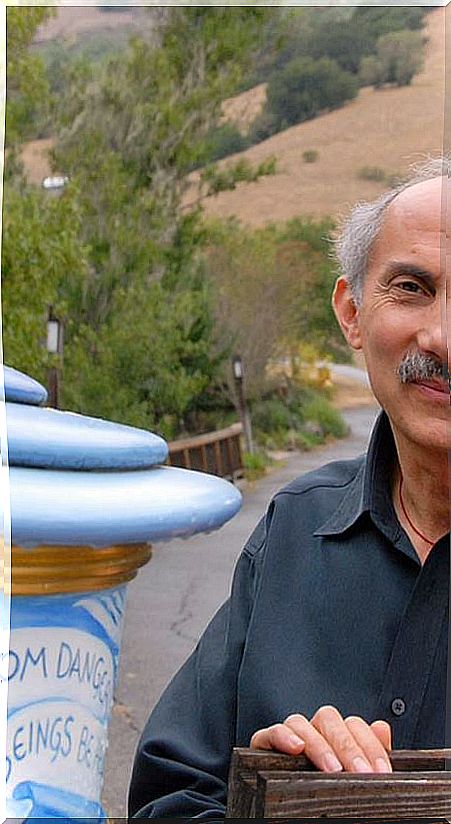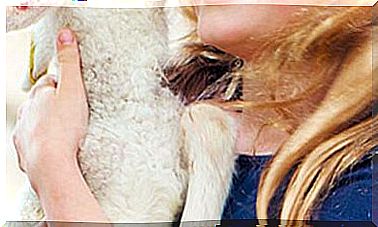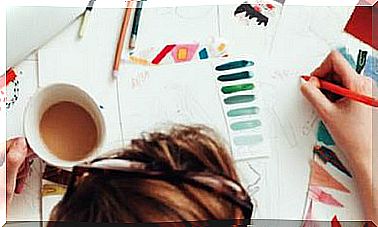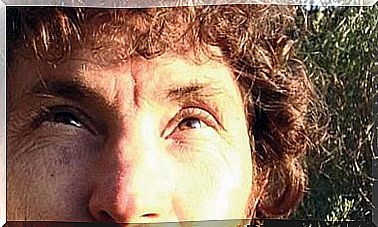“We Live The External And We Don’t Know How To Take Care Of The Inner Life”
We spoke in depth with Jack Kornfield, the popular Buddhist author, about how meditation can improve our lives.

After serving in the peacekeepers in Vietnam, Jack Kornfield trained as a Buddhist monk in various monasteries in Thailand, India, and Burma for about five years. Upon his return to the United States, his native country, he began to look for a way to reconcile the ancient teachings received in Southeast Asia with the Western way of life.
That search has yielded a dozen excellent books translated into more than twenty languages, such as Camino con Corazón , After the ecstasy, the wash , both published by the March Hare, and Meditation for Beginners , published by Kairos.
In addition, Jack Kornfield is a doctor of clinical psychology, a teacher of vipassana meditation since 1974, an activist for the cause of Tibet and a father.
A path of discovery and openness
-He came to Buddhism very young. What attracted you to him?
– I was in a good university and I realized that the study of science, philosophy or history was only part of education. I needed to learn to deal with problems in my family, such as my father’s violence, as well as other aspects of my life. It seemed to me that Buddhism could help me feel better emotionally and mentally, and also more free.
– What led you to train as a monk in monasteries in Southeast Asia?
– During the Vietnam War I applied to join the peacekeeping forces. I wanted to help people, not shoot him. Since I had heard of wonderful Zen masters and was curious if they were still there, I asked to be assigned to a Buddhist country.
In the Mekong River Valley, working with medical teams, I met my future teacher, Achaan Chah. He was cheerful, wise. And I felt that I should stay. I wanted to know how he managed to stay cheerful despite so many difficulties.
– From what you learned what helped you the most on your return?
-So many things. First of all, inner stillness. By meditating, I had learned to calm my mind and have a greater disposition of heart, to be more open, which helped me reach out to others with loving-kindness and compassion. I had also learned what my teacher called “being a witness, ” that is, being the one who knows.
When I was caught up in confusion, I would get angry or irritated, I would take a couple of breaths and could identify that it was simply fear, anger or irritation, and thus the emotions dissolved into the larger space of compassion or compassion. attention. In other words, I learned to regulate my emotions and to be much more present and open to life.
This also makes me think of the story of a young military man who received training in mindfulness to control his anger …
-What happened to him?
– He tells that one day, in line at the supermarket, he started to get angry when he saw that an older woman carrying a baby started talking to the cashier. “Don’t you see there’s a queue and we’re in a hurry?” But when she felt the anger build in her body, she focused on her breathing and relaxed. When it was her turn, she realized that the baby was a boy. He told the woman how beautiful it was and then the cashier intervened: “It is, isn’t it?” She said. “My husband died in Afghanistan and, since I now have to work all day, my mother takes care of him and tries to bring it to me sometimes so I can see it. “
We quickly judge others … and ourselves. Meditation taught me that we can see every emotion and thought that appears within us and distance ourselves from those that are harmful to regain a more innocent look, capable of seeing with love and forgiving.
Buddhism as a psychological tool
– Why did you study psychology after training as a monk?
–My stay in the monastery made me more and more interested in understanding my mind and what I was feeling. At the same time I was aware that in Western society there were many problems related to consumerism, fear, addictions… I thought that meditation and compassion could be useful tools in those cases.
I also began to be interested in the discoveries of neuroscience about how meditation promotes neuroplasticity, emotional regulation or physical healing, and I realized that Western psychology could help me, in addition to understanding myself, to guide better to the people I was already teaching meditation to at the time.
– What would be the greatest difficulty of the human being in his fight against dissatisfaction?
–I would say the lack of self-love. We live in a culture so focused on the external that we do not know how to take care of the inner life, which is our greatest source of happiness.
In a meeting with the Dalai Lama, some Buddhists told him that in the West there was a lot of self-hatred: we wanted to know how to act. The translator needed five minutes to make him understand what we meant, because in Tibetan there is no such word. When he finally understood, his face clouded: “What a big mistake!”
Learning to care for yourself with care and compassion helps you to care for others and to relate kindly. True compassion always includes others and yourself.
– And what would you recommend to improve compassion towards oneself?
–A very useful practice is to start by visualizing two or three people you love or care about. By starting with others, and not with yourself, becoming aware of the degree of suffering or sadness that these people carry, you automatically open yourself to compassion: you want them to feel good, you hug them.
The next step is to visualize these people looking at you and wishing you the same thing: they understand your difficulties, your fears, your confusion … and they invite you to hug yourself, to be the one who puts your hand on your heart and to do for you same what they do for you.
At first it may seem forced, false, even make you feel otherwise or that you don’t deserve love, but with practice compassion takes root, like a well-cared-for plant. And over time you learn that you can give yourself the love that you are capable of giving to others.
A better relationship with the planet
Q: Can Buddhism offer something that other spiritual traditions do not?
– All traditions have their beauty and value. The qualities of Buddhist psychology are its clarity and the fact that it is not based on belief. It is a state of mind that provides beautiful and proven tools to gain balance, cultivate equanimity, have a calm heart, calm the mind and, ultimately, respond to the world from the best of yourself. This helps personally, but also interpersonally. Neither the internet, nor biology nor nanotechnology will stop the arms race, racism or environmental destruction.
Advances require a transformation of consciousness : we must assume our inherent relationship with the water and air of the entire planet, know how to treat each other with compassion and respect. Buddhist psychology preaches the dignity of all living beings, human or not. Understanding this inaugurates a new way of relating to the world.
“The greatest source of joy there can be is connecting with yourself and the world.”
How meditation transforms us
– Many seek in the East extraordinary experiences or “special effects” … –
I wrote about it in my book After the ecstasy, the laundry . Sometimes you can have experiences of ecstasy or bliss, but then they pass. And meditation is not the only place where they can occur. We can feel like this when watching a sunset, when walking in the mountains, when making love, when sitting next to someone when they die and facing the mystery of death.
What meditation offers is a way to open up to these things by being present. Instead of looking for a special experience, it is about realizing that life is, in itself, special effects, being present in the 10,000 joys and 10,000 sorrows that make us human and being able to live with gratitude, balance and love.
–We always want more… Why is it hard for us to settle for what we have?
“I think it was Socrates who said that he liked to walk through the market and observe all the things he could do without.” Through advertising and comparisons in education we are led to believe that the more material goods we have, the happier we will be. However, both among the poor and the rich there are happy and unhappy people.
In this society that fuels speed, addictions, and the rush to get things done, we lose touch with ourselves. And when we try to meditate or relax we often discover an emptiness or what the heart has left unfinished: tears and sorrows that we have not shared, creativity or unspoken desires …
Meditation allows us to witness all these feelings and realize that the deepest happiness lies beneath the surface of our desires, that within us we harbor a source of well-being, liveliness and presence.
– Should we then give up wanting more?
– Someone once said: “I have the best collection of seashells. I keep them along all the beaches of the planet.” Instead of wanting to be owners of things, we can be aware that it is possible to be happy for no specific reason, that the greatest source of joy there can be is to satisfy our most authentic desire, to connect with ourselves and with the world.
The ultimate goal of spiritual practice or Buddhist psychology is not to perfect ourselves but to perfect our love and well-being and be able to share it with others.
Train yourself with patience and love
–When you meditate, you become aware of the mind’s tendency to be distracted. How is this trend modified?
–When you meditate, you can see that your mind is full of worries, confusion, doubts about yourself, plans, judgments, memories with which you try to remedy the past …
The nice thing is that you can train your attention to move away from that mental busyness and direct it towards something as simple as breathing, compassion or the sensations of the body and, in this way, move towards a state of greater mental relaxation and well-being. emotional. That training should be systematic and friendly.
–It is said quickly…
–I like to compare it with when you train a puppy dog : if you say “stay, sit down”, does it obey? Nothing of that! he gets up and runs. If you insist, he will leave again, maybe he will urinate in a corner … hitting him does not work: he does not like it and you feel bad. You wash it and try again.
It is by lovingly and patiently repeating simple instructions that they eventually learn. The mind does more damage than a dog, but if you train it kindly – “be still, sit down” – avoiding judgment, little by little it also learns to navigate in greater harmony with the body and to open up to the mystery of life and its beauty.
“Naming what is experienced allows not only to tolerate it but to reconcile with it.”
A way to combat anxiety
–It is advisable during practice to name what you feel and experience at each moment. Why?
–When you identify what is happening to you and you say to yourself “Ah, this is boredom, loneliness, restlessness, fear “, you move away to see it from a distance. Your attention can be more than what you experience: you get out of there and you gain freedom. Otherwise, as soon as you get bored, restless or lonely, your first impulse is to open the fridge or go online.
Naming what you experience and continuing to be present not only allows you to tolerate it but also to reconcile yourself with it.
– How would this technique be applied if you suffer from anxiety?
-The process is the same: you can bring your attention to anxiety, with compassion, and name it: this is fear, it is anxiety … instead of judging yourself, you can put your hand affectionately to your chest, to your body, and recognize that state that we can all feel at some point.
You can look at the thoughts, which tell stories that may be false. As Mark Twain said: “My life has been full of terrible misfortunes, many of which never happened.” So you can gradually recover a calm breath, allow yourself to feel, sitting like the Buddha that you are, the thousand generations of your family (your grandparents, great-grandparents, great-great-grandparents …), who were, like you, some survivors of that river of the life that you are a part of and in which you can also trust.
The tendency to judge and judge ourselves
– How can we stop our tendency to judge?
– Judging is a problem in meditation and in life. But if you tell yourself to stop judging yourself or others, or get angry when others judge, what is that but another way of judging?
There is another option: use your attention to see that it is the mind that makes the judgment. You can say to yourself “Here is the mind that judges; hi, thanks for your opinion”, even imagine that you are bowing, and thus not taking your judgment so seriously.
Meditating shouldn’t be a chore ; it should be an invitation to benevolence and to be present. The goal is not self-perfection. Florida novelist Scott Maxwell wrote, “No matter how old a mother is, she will continue to wait for signs that her grown children continue to improve.” Well, we do the same with ourselves: we constantly think that we should improve and we judge ourselves.
“Instead of telling yourself not to judge, take your mind off your mind to see that it is the mind that makes the judgment.”
To meditate is to accept the embodiment of the mystery of life and embrace it with a wise and compassionate heart, that is, to rest in a timeless joy that accepts life with its joys and sorrows. And so, as the mind becomes silent, a new clarity or “discriminating wisdom” arises, different from the judging mind. This wisdom allows us to know what to do, to realize whether a response is healthy or not: it determines our way of responding to the world.
– His teacher said “If you do not cry enough, your meditation has not started” … –
When you allow yourself to sit in silence, all facets of your life emerge: your creativity, your ideas about what could happen or be done, people that you care about, the beautiful moments of your life, but also those that were difficult, the penalties or pending subjects.
Therefore, when you meditate there are moments of joy and moments for tears. Both are part of that process of opening and softening the heart that meditation involves and that helps to forge a greater connection with life.
– The relationship with the body is basic in spiritual growth. What do you recommend in this regard?
– At the speed of life today we lose contact with our body. We stop eating well, exercising, treating the body with affection … and not because it is difficult to take care of ourselves but because we lose the joy that comes with inhabiting the body.
Meditation helps to do so by promoting the union between the body and the mind. It invites you to enjoy the experience of being human and to do something beautiful to contribute to it.
The ultimate goal of meditation
–Vicente Ferrer used to say that “good action is the most spiritual act of the human being”…
–In Japan they say that there are only two things to do: sit down and sweep the garden. And it doesn’t matter how big the garden is. Meditative practice is used to calm the mind, reconnect with oneself and cultivate compassion, but then the hungry are fed, the sick are cared for, a sustainable business is set up… the world is served.
It is like breathing in and out. You do not meditate to become a good meditator but to live silence and stillness, and know how to transform them into action.
– Where do you get the strength to meditate and not give up?
–In the beginning you have to make it easy for yourself. You can take a course, but the important thing, in class or at home, is to start with just a few minutes a day (three, five…) and choose a good time.
Do not do it in the morning if you have a hard time getting up, because you will end up getting angry with yourself and leaving it. If difficulties arise, treat yourself with understanding ; put your hand on your heart and embrace those difficulties. Thus, even if you start with small doses, you can feel how the practice nourishes you instead of living it as an obligation.
– Do you have any favorite meditation?
– One that I really enjoy is loving-kindness meditation. I like to do it on the plane or the train. Everyone is sitting absorbed in their things, me too, and suddenly I look around and begin to think of each person wishing him well: that teenager, will he be okay? The old woman in the back, will she be attended to? Or that man, will he go to work?
Little by little I feel that I can love all those people, I could even say goodbye to them at the end of the journey. That transforms my day: I no longer feel isolated but grateful and connected.
– What do you think of holotropic respiration?
–I worked with Stanislav and Christina Grof for many years. It is a very powerful tool. Through deep breathing and music he invites people to open up to all dimensions of their humanity. In my opinion she is a healer and very intelligently combines the western and eastern philosophies on personal growth.
– What has been most difficult for you on your spiritual path?
– The same as everyone. Although I have improved somewhat, I am quite impatient. And there are times when I worry more than necessary or when I find it difficult to assimilate losses that have been important to me … even face my own death.
I feel like I have learned a lot and that my life is quite beautiful, and I am grateful for that. Now I still have my problems. Maybe I don’t take them so seriously: my body can get sick or my personality can have facets that are not exactly that of a Buddha, but I can smile and realize that this is the human incarnation.
– And what is your greatest satisfaction today?
–All this has transformed my life but now, in addition, thanks to scientific research, Buddhist practice is being used in clinics to improve people’s health, in schools to educate children emotionally, for ecology to help protect the environment. planet. .. in so many things that matter to me!









